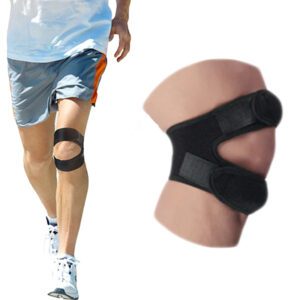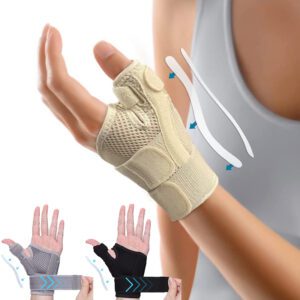This article was first published on trendbaron.com
Knee pain is a common and certainly unpleasant condition that may at first seem like nothing to worry about. However, discomfort or pain in the knee zone is an alarm that should not be ignored. After all – the sooner you react, the better chance you have of successfully eliminating the pain without any surgical treatments.
Regardless of your age, career, or hobby, it is worth mentioning that you are not a hundred percent safe when it comes to knee pain. It is a popular complaint that affects people of all ages. Pain in the knees may only slightly affect your life but if the condition progresses and develops, it can even prevent you from being able to go through your days as usual. It may influence your jobs, your daily activities, even your sleeping pattern.
With that said, we can conclude that knee pain is not something to turn a shoulder to. Instead, the discomfort should be faced and dealt with as soon as possible. Today, we will examine some of the reasons for knee pain and see where the causes originate from. By understanding knee pain in depth you will be better prepared to act and solve the puzzle to return to a normal and satisfactory lifestyle.
How will you know it is knee pain in the first place?

When we say knee pain most of you will probably imagine literally unbearable pain. However, this may not always be the only symptom that something is wrong. Depending on the nature of the problem, discomfort in the knees can be diverse. Some of the most popular symptoms that usually go hand-in-hand with knee pain are:
- Swelling
- Stiffness
- Redness in the knee zone
- Increased temperature around the knees
- Weakness or less stability
- Unusual noises during movement
- Pain when trying to straighten the knee
The cause may sometimes be a previous injury but it can also turn out that you are experiencing knee pain as a result of a wide array of other reasons. It is advisable to visit a doctor or other medical expert as soon as you feel discomfort. To be more prepared and even avoid knee pain, let’s take a look at some of the most common causes.
Top reasons why you may be experiencing knee pain
We already mentioned injuries, which certainly are at the top of the list. But they are not the only reason for knee pain. There are other causes and risk factors, which may cause the condition. We’ll start with a more detailed look at the different injuries which may lead to pain and we will then move on to other, more mechanical issues and complications that may influence the knee.
Injuries that lead to knee pain
For starters, let’s note that injuries are not only related to extremely physically active individuals. A knee injury or trauma can take place even if you are not a bodybuilder, professional football player, or mountain climber. It can occur anytime, anywhere.
Injuries related to the knees can severely influence the ligaments, tendons, bones, cartilage, and even the ligaments responsible for the formation of the joint. In other words, they are a pretty serious reason to visit a doctor and receive professional guidance and treatment. Some of the most popular injuries include:
Torn Meniscus
Among the most popular knee injuries, a torn meniscus can happen as a result of twisting or rotating the knee by putting too much weight on it. Due to the large amount of pressure, the meniscus can tear, leading to severe pain.
Both knees comprise of two C-shaped cartilage pieces. They play the role of a cushion that stands between the shinbone and the thighbone. Tearing the meniscus often results in swelling, stiffness, a blocked knee and overall discomfort and pain in the area. Symptoms such as popping, swelling, pain when rotating the knee, inability to straighten the knee, or feeling that it is simply not as strong as usual are all related to a torn meniscus.
Knee Bursitis
The injury related to inflammation of the bursa or the small fluid-filled sac located near the knee joint. Although any bursa in the knee be injured or become inflamed, knee bursitis in particular takes place on the kneecap or in the inner side of the knee, just under the joint.
This condition can seriously decrease and even limit your mobility and its treatment is rarely successful without the intervention of a medical professional. Depending on the purpose behind the inflammation, symptoms can be different. Overall, patients notice warmth or swelling in the area, along with pain during movement. People whose jobs involve kneeling on hard surfaces are more exposed to this injury. At first, the symptoms are not that serious but take caution if you notice any discomfort.
Patellar Tendinitis
If you are a skier, cyclist, runner, or are involved in other sports, which require a lot of jumping, then patellar tendinitis is something worth familiarizing yourself with. There is a reason why this injury is also called the jumper’s knee.
Patellar tendinitis is related to injuring the tendon connecting the patella or your kneecap to your shinbone. Together, the patellar tendon and the muscles work to make it possible for you to extend your knee and perform kicks, jumps, or running. We mentioned that the injury is more common for those actively participating in sports such as volleyball or basketball but that certainly doesn’t mean that the it is only limited to this group of people.
Symptoms of patellar tendinitis are usually pain between the kneecap and the tibia. In the beginning, pain is only registered after a workout or during physical activity. However, as the condition develops, the pain becomes more difficult to handle and the discomfort is felt more often.
ACL
An ACL injury is the tearing of the anterior cruciate ligament or the ACL – a ligament that connects the shinbone to the thighbone. Similar to the previous cause for knee pain, ACL injuries also occur more often among athletes involved in sports such as basketball or soccer. The main difference here is that ACL injury is most likely to occur during activities, which involve sudden stops or changes in direction.
You will most likely be aware if you’ve suffered an ACL injury as you’ll feel and maybe even hear a “pop” in the knee. Other symptoms include swelling, instability, or unbearable pain.
Knee Fractures
Fractures of the bones of the knee are another serious injury, which may have a long-term impact on the knees, leading to knee pain. The injury can take place during a wide range of physical activities or motor vehicle collisions. Fractures can even be a result of a fall.
Depending on the strength of the knee, fractures will have a different impact and influence. For instance, individuals who suffer from osteoporosis can have a fracture from simply stepping the wrong way. This is due to the fact that the bones are weakened as a result of the condition.
These are the most commonly seen injuries leading to knee pain. This is certainly not the end of our list, however. There are other mechanical reasons to experience knee pain. Some of the mechanical issues include:
- Dislocated kneecap: A dislocated kneecap is a serious reason for pain. This problem takes place when the patella shifts out of place and enters the outside part of your knee, instead of being positioned on the front of the knee. The kneecap can remain dislocated for a long period of time if not treated.
- Broken cartilage: As the bones degenerate, it is possible that a piece of bone or cartilage can separate from the rest and float in the joint space. The broken piece may not cause any problems for a while but if it affects the movement of the knee joint, the individual can experience pain and significant discomfort.
- Iliotibial band syndrome: This is a problem that usually affects distance runners or cyclists. The condition takes places once the iliotibial band tightens to an extent that it starts rubbing against the outer portion of the femur.
- Obesity: You may be surprised but being overweight can also be a factor behind knee pain. Putting too much pressure on the knees can have a long-term impact in the future.
As you can see, the reasons behind knee pain can be many and very different from one another. Especially if you are involved in physical activities, it may be a good idea to keep an eye on the condition of the knees. As soon as you notice something different which is causing you discomfort, it is advisable to visit a professional or take measures to preventing the pain from developing further. Healthy knees means a happier and more active lifestyle!





















